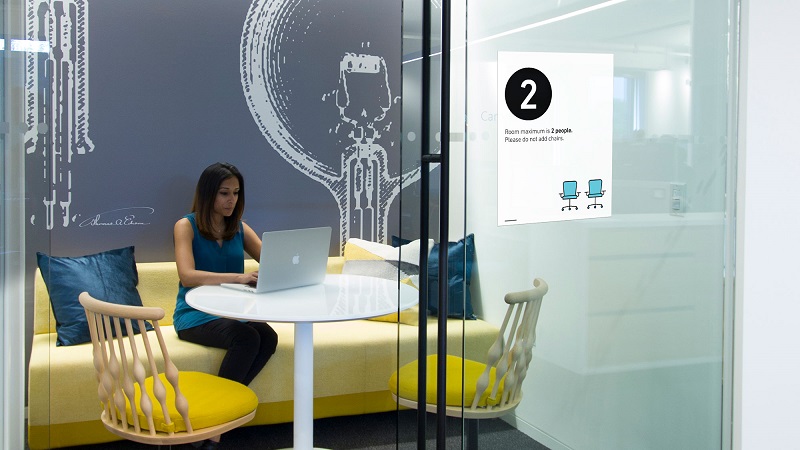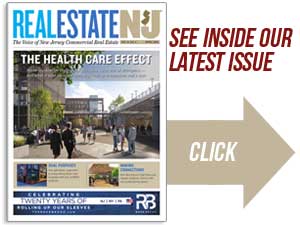Brokers, architects and other commercial real estate professionals are now advising office landlords and tenants on the process of returning to the workplace, outlining strategies such as de-densification, ramped up cleaning and sanitizing and communication to help keep workers informed and ensure social distancing.
By Joshua Burd
Prior to entering the commercial real estate industry, Andrew Judd recalled his time with an engineering and architectural firm whose clients included the region’s major transit agencies.
Those clients shared a common mantra.

“They said the main goal of each of those transit agencies when serving the public is to provide safe, reliable, convenient service,” said Judd, Cushman & Wakefield’s managing principal in New Jersey. “And that was the order — safety is first, reliability is second, convenience is third.”
He expects to see similar principles in play as office building owners and occupiers help employees return to work in the aftermath of the COVID-19 crisis
“The first thing you have to get to is that it’s got to be safe and people have to feel that way,” Judd said. “Then you have to figure out the reliability of it going forward. And then the convenience will be what works for each individual business.”
Such is the focus for a host of real estate services firms, architects and other professionals who are now advising landlords and tenants on the process of re-entry. There is likely no one-size-fits-all approach, but they point to several key strategies that should be common threads in the near term: de-densification, ramped up cleaning and sanitizing and communication to help keep workers informed and ensure social distancing.

“Everybody is learning from each other and there’s a lot of considerations that are being discussed,” said Reid Brockmeier, a principal and co-managing director of Gensler’s New Jersey office. He noted that those discussions don’t necessarily call for a large capital investment initially.
“If it’s going to make a big difference in terms of how people feel comfortable, yes, but there’s a lot of things that relate more to protocols and procedures that they’re realizing tenants are really concerned about right now.”
For instance, corporate occupiers are almost universally thinking about staggered schedules and allowing only a percentage of their employees to return to work as part of a phased approach. Landlords will also have a hand in controlling elevator traffic, sanitizing common areas and providing directional signage for spaces such as stairwells.
Other changes, including those that alter individual tenant spaces, may be longer-term in nature. But experts say they could come at the expense of some recent design trends: higher headcounts per square foot, unassigned workstations and a focus on collaborative spaces, to name a few.

“(With) all of these spaces, because they were catering to collaboration, they’re now going to have to figure out a way to either monitor that in terms of the amount of use — and who’s using it over time — or capture that space as part of the spread-out, if you will,” said Cammy Hardison, director of interiors with Rotwein+Blake in Livingston. “It will be interesting to see going forward how some of these companies address those issues.”
Hardison said she believes open office layouts will remain largely intact because they provide the benefit of natural light, circulation and ventilation. But that may not stop tenants from modifying their workstations or the spacing between them.
In the meantime, major real estate services firms have begun to issue guidance for both landlord and tenant clients. For its part, Cushman & Wakefield recently unveiled a how-to guide for reopening the workplace that includes a “Safe Six” checklist covering everything from HVAC checks to controlling access to increased cleaning and reducing touchpoints.
The firm is looking to draw in part from its experience in China, where it recently helped put some 1 million workers across 10,000 companies back to work as the country sought to emerge from its coronavirus outbreak earlier this year.
“The underlying understanding is that this is going to be a partnership with everybody, so not only a private-public partnership, but also at the individual building level,” said Judd, who is based in C&W’s East Rutherford office. “This is going to be a partnership between occupiers and owners because one has to be in tandem with the other.”

Brenda Nyce-Taylor, a principal with Gensler, said clients are in fact thinking about long-term solutions, but have also considered how to quickly and cost-effectively address employee concerns on day one of going back to work. Those short-term fixes include creating cleaning stations that can give employees more control over the environment, she said, while companies and their professionals take more time to consider options such as self-sanitizing materials.

She also pointed to more immediate “interventions” such as removing the door to a vestibule leading into a bathroom, if it can be done while still providing privacy, rather than immediately installing automatic doors.
“I think they really don’t want to have kneejerk reactions by making significant changes that they may look back on and say, ‘Why did I make such a big impact either to my space or from a cost perspective?’” said Nyce-Taylor, also a co-managing director of Gensler’s Morristown office. “So I think they’re cautious because they realize that, as we’re still learning about this disease, we need to adjust and readjust in approach.”
Design experts also note that tenants may now have time on their side more than they previously thought, given advances in technology and the growing comfort level with remote working. To that end, some companies may be more patient in waiting for better coronavirus treatments or even a vaccine.

“Certainly they want to get back, but in the short term I believe that companies have gotten more adept or used to working from home,” said Lance Blake, president of Rotwein+Blake. “The technology is there or they’re investing in the technology, and I think that right now, in their current footprints, they are going to spread out. I think they’re going to adapt from a management point of view rather than from a design point of view at the moment.
“I certainly think that there will be changes in design philosophy as we move forward, but that’s going to be an evolution.”
That won’t stop brokers and designers from having those conversations with owners and occupiers. For landlords, those discussions will highlight the need to have clean, sanitized buildings with strong mechanical infrastructure as a means of staying competitive.
“Unlike any other thing that we’ve gone through, buildings will have to do these things,” Judd said. “Otherwise tenants will say, ‘You’re not giving me a safe place to keep our people.’
“And the occupants, including corporations and small businesses alike, will have to do the same thing for their people.”
As recently as three months ago, landlords used amenities and other perks as a means of repositioning their buildings and distinguishing them from New Jersey’s older office stock.
“Amenities are almost secondary at this point,” Judd said. “It used to be it was enough to have a plug-in for electric vehicles, you’re offering rideshare programs and you have free WiFi and a gym and a cafeteria. All that’s changed now.
“Maybe you don’t necessarily need a gym or can’t have a gym. Maybe the cafeteria doesn’t even exist anymore and now the competitive edge of one building over another is how safe is it or how clean is it?”










